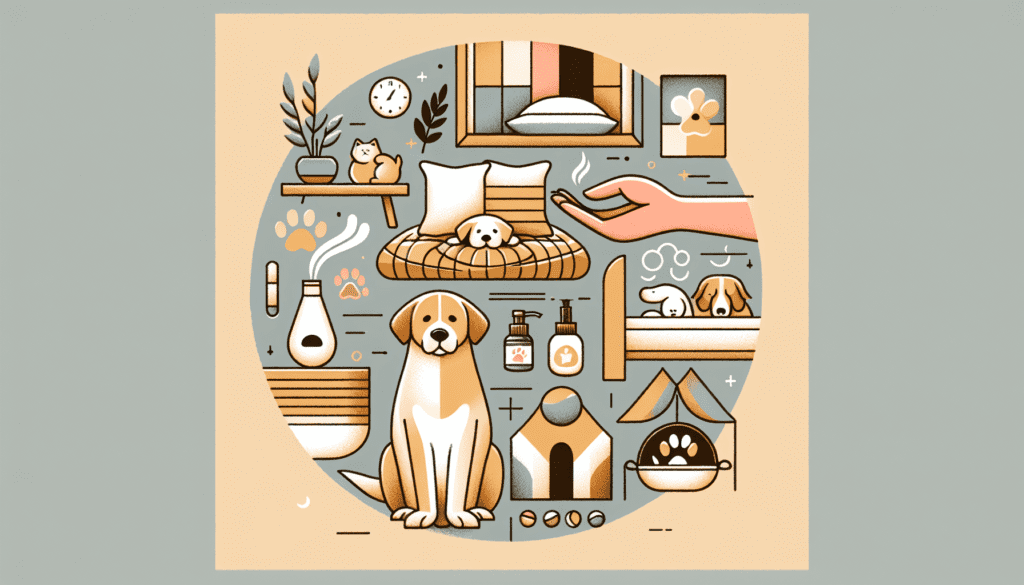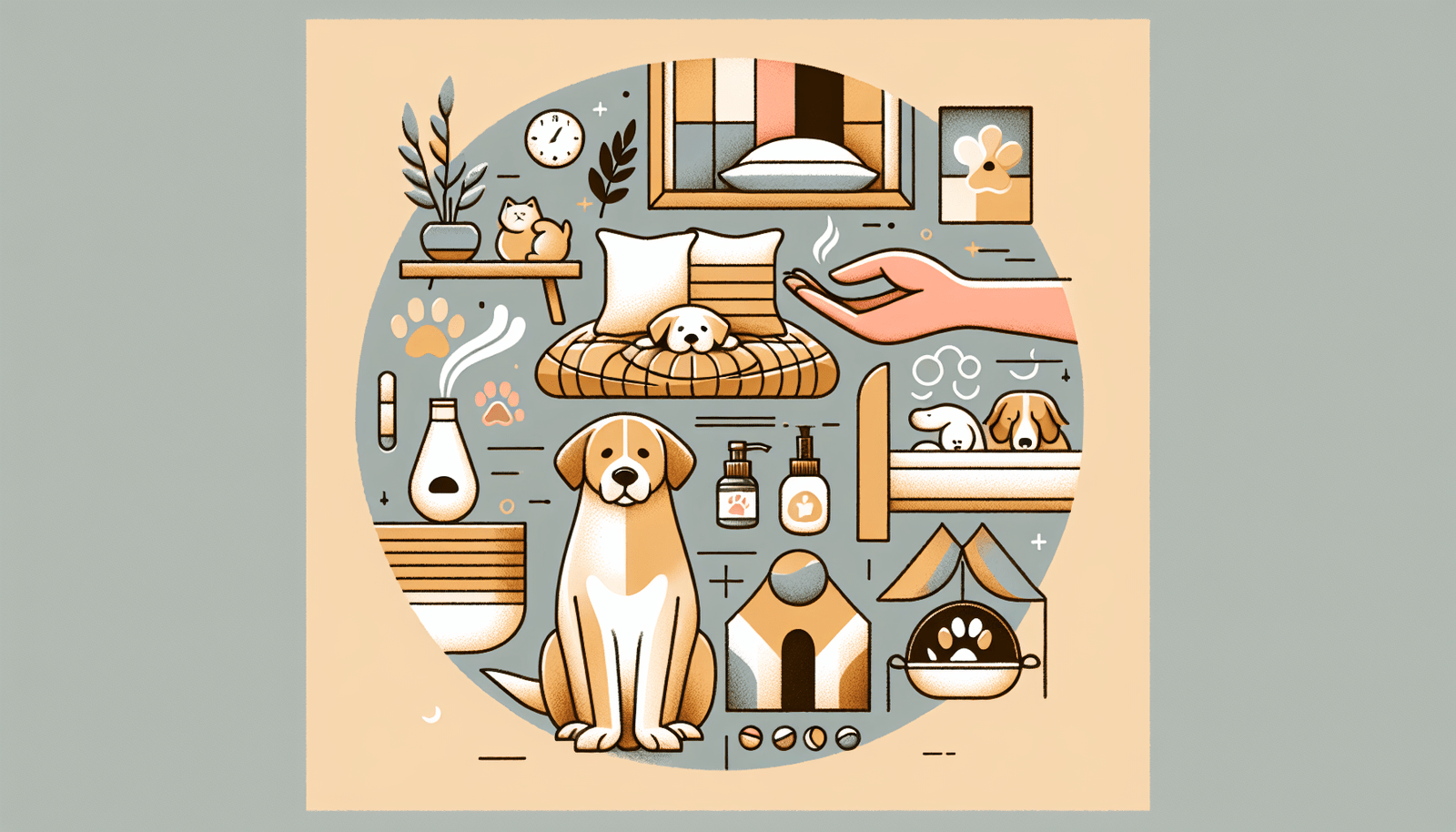If you have an anxious dog, you understand the importance of creating a safe and comforting environment for them. Dogs, just like humans, can experience fear and anxiety, and it’s our responsibility as their caregivers to provide them with a sense of security. Creating a safe haven for your furry friend not only helps alleviate their anxiety but also strengthens the bond between you and your pet. In this article, we will explore practical tips and strategies to create a safe and comforting environment for your anxious dog, enabling them to lead a happier and more relaxed life.
Understand your dog’s anxiety
If you have an anxious dog, it’s important to understand their anxiety and how it can manifest. Dogs can experience anxiety for various reasons, including separation anxiety, fear of loud noises, or unfamiliar situations. By recognizing the signs of anxiety, you can better address your dog’s needs and provide the necessary support.
Recognize the signs of anxiety
Anxiety in dogs can present itself in several ways. Some common signs include excessive panting, trembling, pacing, whining, or destructive behavior. Your dog may also show signs of restlessness, loss of appetite, or try to escape from certain situations. It’s crucial to pay attention to these behaviors and look for patterns to identify triggers that may be causing your dog’s anxiety.
Identify triggers for your dog’s anxiety
Identifying the triggers for your dog’s anxiety is an essential step in helping them feel more secure and comfortable. Common triggers can include loud noises, such as thunderstorms or fireworks, being left alone, visits to the veterinarian, or encounters with unfamiliar people or animals. By understanding what triggers your dog’s anxiety, you can take steps to minimize their exposure or help them gradually become less fearful.
Consult with a veterinarian or animal behaviorist
If you’re unsure about how to manage your dog’s anxiety, it’s always a good idea to seek guidance from a veterinarian or animal behaviorist. They can provide professional advice tailored to your dog’s specific needs. A veterinarian may also be able to explore medical options, such as prescribing anti-anxiety medications, to alleviate your dog’s symptoms and improve their quality of life.
Provide a calm and predictable routine
Establishing a calm and predictable routine is crucial in helping your anxious dog feel secure and reduce their anxiety levels. Dogs thrive on structure and knowing what to expect, so implementing a daily schedule can greatly benefit them.
Establish a daily schedule
Try to establish a set daily routine for your dog, including designated times for meals, exercise, and rest. Dogs are creatures of habit, and having a consistent schedule can promote a sense of security and stability. This routine will also help reduce any uncertainty or anxiety your dog may feel about when they’ll receive food, playtime, or other activities.
Maintain consistency in feeding and exercise times
Consistency is key when it comes to feeding and exercise for your anxious dog. Stick to consistent meal times to establish a routine and help your dog feel secure knowing they’ll be regularly fed. Similarly, maintaining a consistent exercise schedule will provide mental and physical stimulation, which can aid in reducing anxiety.
Create a quiet and comfortable sleeping area
A quiet and comfortable sleeping area can play a significant role in helping your anxious dog feel safe and secure. Provide a cozy and inviting bed in a location of the house that is away from any potential distractions or loud noises. Consider using soft bedding and creating a den-like space that your dog can retreat to when they need some peace and quiet. This designated sleeping area should be a place where they can relax and unwind, free from any sources of stress or anxiety.

Create a safe physical environment
Creating a safe physical environment is crucial for the well-being of any dog, but especially for those with anxiety. By removing potential hazards and ensuring your home and yard are secure, you can help alleviate any anxiety your dog may have about their surroundings.
Secure your home and yard
Take the necessary steps to secure your home and yard to prevent your anxious dog from escaping or potentially injuring themselves. Make sure fences are sturdy and free from any gaps or holes that could allow your dog to escape. Check windows and doors for any openings that could provide an escape route for your dog. By creating a secure environment, you can help alleviate their anxiety about being outside or away from you.
Remove potential hazards
Dogs can be curious creatures, and it’s important to remove any potential hazards that may cause anxiety or harm to your dog. Keep toxic substances, such as cleaning supplies or chemicals, safely stored in cabinets out of your dog’s reach. Ensure that electrical cords are out of your dog’s way to prevent chewing or tripping accidents. By eliminating potential hazards, you can reduce anxiety and create a safer environment for your furry friend.
Use safety gates or crates when necessary
Safety gates and crates can be valuable tools in creating a safe physical environment for your anxious dog. If certain areas of your home pose a greater risk or trigger anxiety for your dog, consider using safety gates to restrict access. Crates can also provide a cozy and secure space where your dog can retreat to when they need a moment of calm. Make sure the crate is appropriately sized and comfortable, and introduce it gradually to prevent any negative associations or feelings of confinement.
Establish a designated ‘safe space’
Creating a designated ‘safe space’ for your anxious dog can provide them with a refuge where they can feel protected and secure. This safe space should be tailored to your dog’s specific needs and preferences.
Choose a quiet and secluded area
When establishing a safe space for your dog, choose a quiet and secluded area of your home where they can retreat to when they feel anxious. This could be a spare room, a nook under the stairs, or even a crate covered with a blanket. By selecting a location away from noise and distractions, you can help your dog find solace in their safe space whenever they need it.
Make the space cozy and inviting
Create a cozy and inviting environment within your dog’s safe space. Provide soft bedding or blankets that are comforting to them. Consider adding their favorite toys or a piece of clothing with your scent to create a familiar and secure atmosphere. Adding a plush bed or pillows can also enhance the coziness of the space and make it more appealing for your dog.
Use pheromone diffusers or calming music
Pheromone diffusers or calming music can be effective in helping to reduce your dog’s anxiety within their safe space. Pheromone diffusers emit synthetic versions of calming pheromones that can help create a sense of security and well-being for your dog. Calming music specifically designed for dogs can also have a soothing effect on their nervous system. Experiment with different options to find what works best for your furry friend.

Engage in anxiety-reducing activities
Keeping your anxious dog engaged in anxiety-reducing activities can help divert their focus and alleviate their anxiety. By providing both physical and mental stimulation, you can help your dog relax and feel more at ease.
Regular exercise and mental stimulation
Regular exercise is essential for promoting physical and mental well-being in dogs. Engage in daily walks, play sessions, or other forms of exercise that your dog enjoys. Not only does exercise help release pent-up energy, but it also stimulates the production of endorphins, which can boost your dog’s mood and help reduce anxiety. Additionally, mental stimulation through activities like puzzle toys or obedience training can provide a positive outlet for your dog’s energy and help divert their attention from anxious thoughts or triggers.
Try puzzle toys or treat-dispensing toys
Puzzle toys or treat-dispensing toys are excellent tools for providing mental stimulation and distracting your anxious dog from their fears or triggers. These toys require your dog to solve a puzzle or work to retrieve treats, keeping them engaged and focused. They can help redirect your dog’s attention away from their anxiety and provide an enjoyable outlet for their energy.
Consider scent-based activities like nose work
Scent-based activities, such as nose work or scent detection games, can be highly beneficial for anxious dogs. These activities tap into a dog’s natural scenting abilities and provide mental stimulation and a sense of accomplishment. By encouraging your dog to use their nose to find hidden treats or objects, you can help redirect their attention away from anxiety-inducing stimuli and provide a fun and rewarding outlet for their energy.
Practice positive reinforcement training
Positive reinforcement training is a highly effective method for reducing anxiety in dogs while building a strong bond and trust between you and your furry friend. By using positive and gentle training methods, you can help your anxious dog feel more confident and secure.
Reward desired behaviors with treats or praise
When training your anxious dog, always use positive reinforcement by rewarding desired behaviors with treats or praise. This positive association helps your dog understand what behaviors are expected of them and motivates them to repeat those actions. It also allows your dog to associate training sessions with positive experiences, which can counteract any negative emotions or anxiety they may have.
Use positive and gentle training methods
Avoid using punishment or harsh training methods with your anxious dog, as this can exacerbate their anxiety and lead to further distress. Instead, opt for positive and gentle training methods that focus on rewarding good behavior, shaping desirable habits, and building your dog’s confidence. Patience, consistency, and understanding are key when working with an anxious dog, as progress may take time.
Consider professional training or obedience classes
If you’re struggling to address your dog’s anxiety through training alone, consider seeking professional help. Enrolling your dog in obedience classes or working with a certified dog trainer can provide expert guidance and support. They can tailor training techniques to suit your dog’s specific needs and help you develop strategies to manage their anxiety effectively.
Utilize natural calming aids
In addition to behavioral interventions, certain natural calming aids can help alleviate your dog’s anxiety. These aids can be used in conjunction with other management strategies to create a more soothing environment.
Use CBD products or herbal supplements
CBD products and herbal supplements have gained popularity as natural remedies for anxiety in dogs. CBD, or cannabidiol, has calming properties and can help promote relaxation without the psychoactive effects of THC. Herbal supplements such as chamomile or valerian root can also have a calming effect on dogs. However, it’s essential to consult with your veterinarian before introducing any new supplements or products to ensure they are safe and appropriate for your dog.
Try anxiety wraps or vests
Anxiety wraps or vests, such as Thundershirts, apply gentle pressure to your dog’s body, mimicking the sensation of being held or hugged. This pressure can have a calming effect on dogs by promoting the release of calming hormones. Many owners find anxiety wraps or vests beneficial in reducing anxiety during stressful situations, such as fireworks or thunderstorms. It’s important to note that these wraps should be properly fitted and used according to the manufacturer’s instructions.
Explore aromatherapy with dog-friendly essential oils
Aromatherapy can be another useful tool in helping to calm your anxious dog. Dog-friendly essential oils, such as lavender or chamomile, can be diffused in the areas where your dog spends most of their time. The scent of these oils can have a soothing effect on dogs and help create a calming atmosphere. However, it’s crucial to consult with a veterinarian or professional aromatherapist to ensure the use of essential oils is safe for your dog and to determine the appropriate dilution and application methods.
Minimize exposure to triggers
Minimizing your anxious dog’s exposure to triggers is an essential part of managing their anxiety. By avoiding or gradually desensitizing your dog to these triggers, you can help reduce their anxiety levels and build their confidence.
Avoid crowded or noisy environments
If you know that your dog becomes anxious or overwhelmed in crowded or noisy environments, do your best to avoid exposing them to such situations. Opt for quieter walking routes, schedule outings during less busy times, or choose more secluded areas for exercise. By minimizing exposure to triggers, you can help prevent your dog’s anxiety from escalating and make their experiences more enjoyable.
Gradually desensitize your dog to triggers
Gradual desensitization is a technique used to help dogs overcome their fears or anxieties by exposing them to their triggers in a controlled and systematic way. Start by introducing your dog to the trigger at a distance or with a milder intensity, and gradually increase exposure over time. For example, if your dog is fearful of loud noises, you can begin by playing quiet recordings of the noises and gradually increase the volume or intensity over several sessions. This gradual approach can help your dog build confidence and reduce their anxiety response.
Use pheromone sprays or diffusers in trigger areas
Pheromone sprays or diffusers, such as Adaptil, release synthetic versions of calming pheromones that can help reduce anxiety in dogs. Using these sprays in trigger areas, such as the car or the veterinarian’s office, can help create a sense of calm and security for your dog. This can be particularly helpful in situations where complete avoidance of triggers is not possible.
Seek professional help if needed
If your dog’s anxiety persists or becomes severe despite your best efforts, seeking professional help may be necessary. Veterinary behaviorists specialize in addressing behavioral issues in animals and can provide expert guidance tailored to your dog’s specific needs.
Consider medication or anti-anxiety treatments
In some cases, medication or anti-anxiety treatments may be required to manage your dog’s anxiety effectively. Veterinarians can prescribe medications that can help alleviate your dog’s symptoms and improve their overall well-being. These medications should always be used under the supervision of a veterinarian and in conjunction with behavioral interventions.
Consult with a certified veterinary behaviorist
Certified veterinary behaviorists are professionals who have extensive knowledge and experience in diagnosing and treating behavioral issues in animals. They can assess your dog’s specific anxiety triggers, develop a comprehensive treatment plan, and guide you through the process. These experts can provide you with the tools and strategies necessary to help your anxious dog overcome their fears and lead a happier, more relaxed life.
Explore alternative therapies like acupuncture or massage
Alternative therapies such as acupuncture or massage can be beneficial as complementary treatments for anxiety in dogs. Acupuncture involves the insertion of thin needles into specific points on the body to promote relaxation and balance. Massage therapy can help reduce muscle tension, promote circulation, and release endorphins, providing a sense of calm for your dog. These therapies should be performed by qualified professionals experienced in working with animals.
Provide emotional support
Lastly, providing emotional support is crucial for helping your anxious dog feel safe, loved, and understood. Your presence and reassurance can go a long way in helping them navigate their anxiety.
Be patient and understanding
Dealing with an anxious dog requires patience and understanding. Anxiety is a genuine and distressing experience for dogs, and it’s essential to approach their needs with empathy. Recognize that progress may take time and setbacks may occur along the way. By being patient and understanding, you can create an environment that promotes trust and emotional well-being for your dog.
Offer plenty of affection and reassurance
Providing your anxious dog with plenty of affection and reassurance can help alleviate their anxiety and strengthen your bond. Gently stroke or massage your dog when they seem anxious, and speak to them in a calm and soothing tone. Reassure your dog that they are safe and loved, and avoid scolding or punishing them when they exhibit anxious behaviors. Your presence and comfort can go a long way in making your dog feel more secure and less anxious.
Avoid punishment or scolding when your dog is anxious
It’s important to avoid punishment or scolding when your dog is anxious, as this can worsen their anxiety and erode their trust in you. Instead, focus on positive reinforcement and redirecting their attention to more desirable behaviors. Punishment only serves to escalate fear and anxiety in dogs, making it counterproductive and potentially harmful to their mental well-being.
By understanding your dog’s anxiety, creating a calming environment, engaging in anxiety-reducing activities, practicing positive reinforcement training, utilizing natural calming aids when needed, minimizing exposure to triggers, seeking professional help when necessary, and providing emotional support, you can help your anxious dog lead a more peaceful and fulfilling life. Remember, your understanding, care, and love are the keys to helping your dog overcome their anxiety and thrive.

